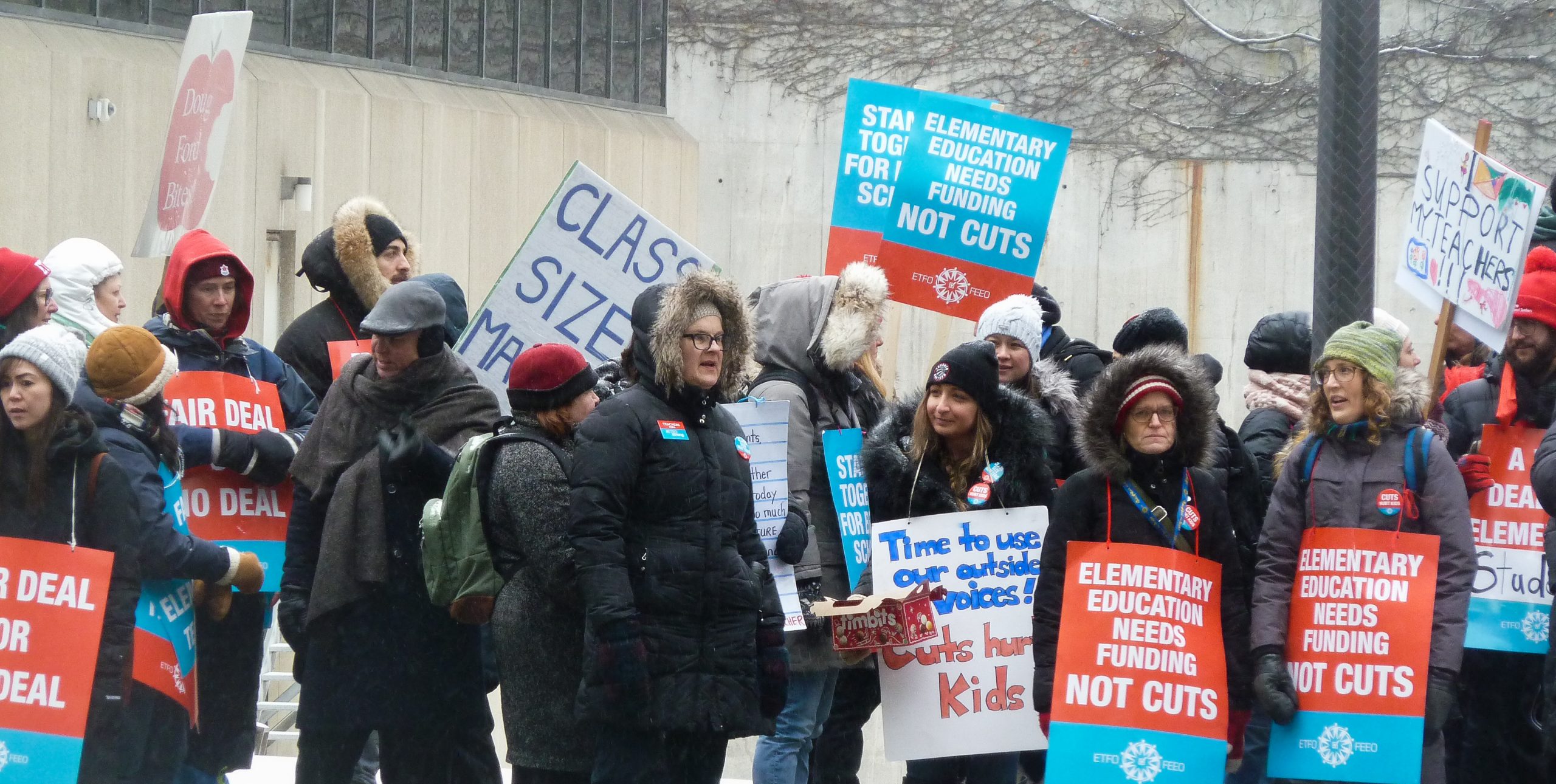ETFO should make it clear where it stands on class size
Ontario educators are out on strike this Friday and they will be supported by parents who have stood behind them since the Ford government swaggered into office in June 2018. It’s all about pushing this disaster of a government to come to a reasonable settlement in contract disputes that have dragged on for months. But make no mistake; it’s also about opposing the corporatist direction every government since Bob Rae’s in the 1990’s has taken with education and so much else. To that end there’ll be a mass rally at Queen’s Park, picket lines at schools and board offices across the province – even a demonstration at the Tory convention in Niagara Falls on Saturday.
This is all terrific, but there is a wrinkle – one which is easily ironed out- but a wrinkle nonetheless. Last Wednesday, Elementary Teachers Federation of Ontario (ETFO) issued Central Bargaining Bulletin # 18 to emphasize its position vis-à-vis the government – just as it was about to engage in the province-wide strike including Ontario Secondary Teachers Federation (OSSTF), Ontario English Catholic Teachers Association (OECTA) and l’association des enseignantes et enseignants franco-ontariens (AEFO) with a combined membership of 200 000 educators.
The key issues “included” (our emphasis) in the bulletin were:
- special education and priority funding to support elementary student’s learning
- getting a firm commitment from the government to maintain the current kindergarten program
- addressing classroom violence
- funding to keep members’ benefits at existing levels
- maintaining the “long-standing fair and transparent” hiring practices established by Regulation274
There was nothing in there about the salary increase that has been on the table since negotiations began. There was also nothing about one key demand: maintaining classes in grades 4-8 at their current average sizes rather than increasing them by one.
Last October, ETFO President Sam Hammond was adamant about keeping class sizes at status quo: “There will be fewer teachers in schools, larger classes and less one-on-one instruction time for students because of Ford’s reckless cuts. Ford is fond of saying that no one will lose their job, but the reality is there will be 1000 fewer public elementary teaches to help students reach their potential.”
Has ETFO’s position changed on this issue? Members of Elementary Teachers of Toronto (ETT) certainly want to know. ETT executive officer, Nigel Barriffe made his concerns known in an open letter to Sam Hammond last Thursday in which he described the class size issue as “the number one issue for the majority of members, not only in Toronto, but across our province.” He went on to describe ETT’s work to help groups organize across the GTA and beyond to confront the Ford government principally over class size. He said that if class size is taken off the bargaining table, it “will have a detrimental effect on the trust that has been built between the parents and our teachers for a generation to come.”
He urged Sam Hammond to clarify ETFO’s position on this issue. Perhaps class-size was left out of the bulletin by mistake. It would be an easy matter to repair.
According to ETFO, class size is still a major issue for negotiations. School got a copy of a message sent by ETFO Collective Bargaining Communications Officer, Lisa Mastrobuono noting “Those reading the bulletin carefully will notice that it references key issues and then uses the word “including”. Including means that the list presented in the bulletin is not an exhaustive list. The issues of class size and salary remain part of ETFO’s proposal at the central table.”
“Including” also means that the issues might have been buried to make them less bothersome for some ETFO members who would sooner than later like to reach a deal with the Ford government. School learned that this may be the case with ETFO- York Region. A call for comment from York Region local president David Clegg hasn’t yet been returned.
“Including” could also be a signal to the Ford government that class size is negotiable under the mistaken belief that it can’t be pushed any further.
Whatever the case, this is not the time for misunderstanding. ETFO needs to make its position on class size crystal-clear. Parents have not gone to all the trouble of supporting teachers because they want to see Regulation 274 stay in place. They want issues concerning funding, special education, kindergarten, school violence and class size to be front and centre. “Included” is not good enough.
Educators and the parents who support them, have put themselves on the line because they see that the issues presented by the Ford government, as it seeks to diminish public education, are far more important than the usual wage and benefits package negotiated between the province and unions. Schools and the people who work in them cannot afford to lose this critical base of support by caving in to fear that the strike might go on too long.
It’s also plain wrong to use class size as a bargaining chip. It was senseless for the Tories to increase the averages; elementary classrooms already face huge problems over discipline and delivering badly needed services to needy kids. Class size should not be relegated to the “included” bin. ETFO needs to make this clear to its membership and supporters.


